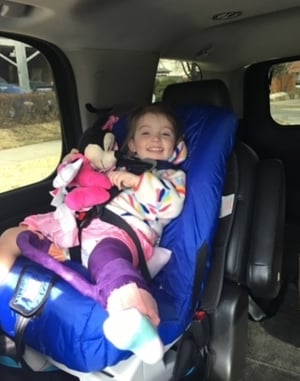Hip Dysplasia: Ella's Story

Seven-year-old Ella is the kind of kid who never sits still. She loves to dance, swim, play softball and soccer, and goof around with her younger brother, Reed. With the help of the
hip care team at Children’s Mercy, Ella’s hip dysplasia doesn’t get in the way of being an on-the-go kid.
When Ella was 2, her parents noticed that her hips were popping during diaper changes. Her parents, Sarah and Matt, shared their concern with Ella’s pediatrician, who referred them to Lisa Berglund, MD, at the Children’s Mercy Kansas City Hip Program. Dr. Berglund diagnosed Ella

with hip dysplasia, a condition that occurs when part of the hip joint does not develop properly.
“We were taken aback by how severe her condition was since it didn’t seem like she was in pain,” Sarah recalled. When Dr. Berglund recommended surgery – a bone graft and tenotomy – Sarah wasn’t sure how her busy toddler would handle the six-week recovery period. “Ella’s our vibrant, vivacious, rough-and-tumble kid,” she said. “Knowing that she was going to have to lie down and not move was so hard!”
The days immediately following the surgery were tough for Ella and her parents. “There was one point after surgery when her pain was really bad,” Sarah shared. “I had to step out of the room because it was so overwhelming – my baby was hurting, and there was nothing I could do. But her nurses were so amazing. Not only did they help Ella feel better, they helped calm me down, too. It meant the world to us to know that there was always someone there with us who was helpful and calm and knowledgeable.”
After six weeks in a cast, Ella was cleared to get up and moving again, and it didn’t take her long at all. Because of her young age, she didn’t need physical therapy. Her daycare provided special toys and support to help her strengthen her legs. In about two weeks, she had already re-taught herself to walk, and she continued to heal quickly.

Ella’s experience has helped other family members get the care they need as well. Two of her second cousins were diagnosed with hip dysplasia as teens, and her brother Reed was screened at Children’s Mercy as a precaution, although he has not had any hip problems so far. Hip dysplasia often runs in families and is more common in firstborn females who were born in the breech position, which was the case for Ella.
Five years after her surgery, Ella has finished her series of yearly follow-up appointments and now will only need to check in with her hip team every three years. “I would say we felt very, very well taken care of, beyond our expectations,” said Sarah. “I don’t think we would have gone anywhere besides Children’s Mercy because we knew the care was going to be exceptional.”
